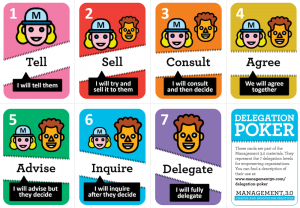How to successfully drive initiatives, objectives or opportunities that require several squads (or teams) to succeed? How to do this in a way that respects the agile mindset without falling into the command-and-control trap? Today, this problem is more complex than it seems. We’ve designed and built our squads for self-organization and autonomy in the
Continue readingUsing a delegation board to foster collaboration
I’m currently coaching a team with several stakeholders in different parts of the organization. It’s difficult to know who to talk to when decisions need to be made. The line between what the team can decide about and what the stakeholders need to be involved in is also blurry. To help create more clarity and a better collaborative environment with our stakeholders we decided to create a delegation board. The meetings we ran this week were appreciated by everybody, so I thought I would share what we did and what we learned.
How to run an internal unconference
An unconference is like a normal conference but with no predefined agenda, no predefined list of speakers, no slides, and…er… actually it’s not very much like a normal conference at all! It’s more like an alternative to a conference. If the purpose of a conference is to collaborate and communicate, then an unconference will often fulfill the
Continue readingWeb Whiteboard – the simplest way to write and draw together online
OK, nothing beats face to face. But suppose you’re not in the same location – because you’re on the phone or a skype call – and you still want to write and draw together. Or you’re on a distributed team and want a simple shared workspace, just like you would if you were in the same
Continue readingSteve Bockmans team estimation
Estimation of the effort to implement and deliver a set of functionality is an important but not always the most fun part of product development. Estimations are done at different detail levels during the project, for example the high level story estimation and the low level task estimation. It is a few years since I did task estimation; many times it is a waste of time doing low level estimations, so in the following text I will describe a technique that I like when estimating the user stories.
Improve your soft skills through physical challenges
It is important to have members with excellent technical skills in most agile projects to succeed deliver desired customer value. But even more important is that the members have great collaborative and communication skills. Without the ability to collaborate efficiently the team will have a tough time to succeed with the project. The soft part of product development includes both how the members act against each other, but also how good they all are in introspectiveness and adaptability. They need this to be able to mature as a team compared to just being a bunch of individuals acting under a common project hat.
There are many ways you can improve your ability to inspect your own behavior and adapt and change it accordingly. Working together with others and asking them to give you feedback is one great way of improving yourselves. Last year I found, a bit surprisingly, another way of improving my skills in collaboration and team work; I took on a personal sport challenge with the goal to perform a race one year ahead. This challenge has learned me a lot about myself and has also improved my collaboration skills.





